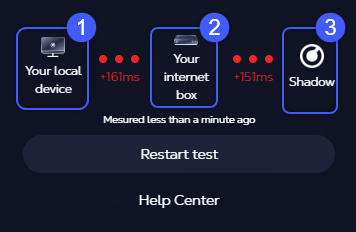How to troubleshoot your internet connection (B2B)
Updated
Shadow PC is a cloud-based, real-time streaming service. A stable, reliable internet connection is important.
Users often identify problems with their local internet connection when they report experiences of stuttering, freezing, lagging, pixelation, or blurriness. If you're experiencing any of these issues, this article may help you to achieve a smooth, stable, and responsive performance.
Read this article to see the best practices for Shadow PC and learn how to troubleshoot your internet connection.
Pre-troubleshooting checklist
Before diving in, make sure you are following the best practices to boost your streaming experience. The suggestions below can help Shadow PC perform optimally.
Troubleshooting instructions
Shadow PC includes a Quick Menu you may use to identify connection issues as well as a speed test.
Quick Menu
The Quick Menu is a special overlay menu available when Shadow PC is streaming. You can use this menu to see statistics about your Shadow PC and change settings without leaving your stream.
To open the Quick Menu, start Shadow PC and click the Shadow PC icon ![]() at the top of the screen.
at the top of the screen.
If you can't see the icon, the Quick Menu is disabled or incompatible with this device. Try using keyboard shortcuts to use Quick Menu commands.
Learn more about the Quick Menu.
Usage stats
To the right of the Quick Menu, you'll see a separate usage stats panel. At a glance, you'll see these 3 icons labelled:
Your local device: The device you're currently using
Your internet box: The internet source (e.g. router or modem) your device is connected to
Shadow: The server where your Shadow PC is hosted

This tests the ping between:
Your local device (1) and your internet box (2), which should be less than 6ms.
Your internet box (2) and Shadow (3), which should be less than 60ms.
Speed test
Shadow provides a speed test to test your connection to your data center, the server where your Shadow PC is hosted. Follow the steps here to run a Speedtest.
Note: The Shadow Speedtest will provide a more accurate representation of your connection than a third-party speed test, which will test the connection to a different server and may not reflect the same results.
If you didn't detect any issues with your connection in this article, review the best practices for improving latency.
Still have questions after reading this article?
Feel free to check out our other articles.
You can also contact Shadow support via our form.

